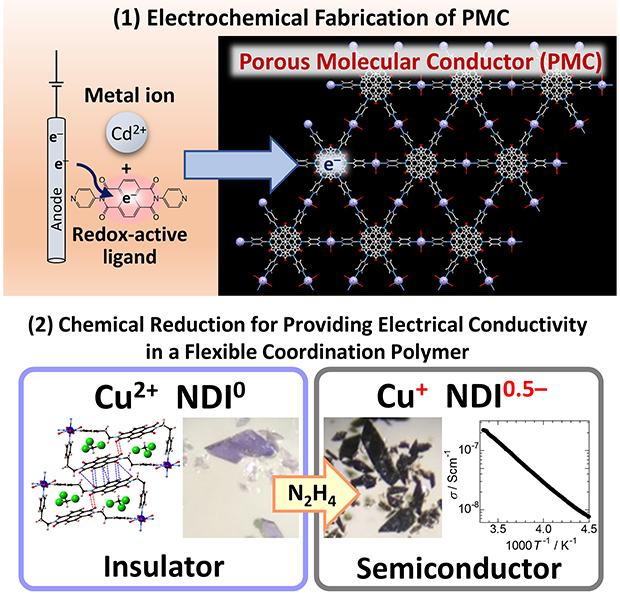The first porous molecular conductor (PMC), which exhibits porosity, a through-space conduction pathway and rich charge carriers (electrons), was prepared through electrocrystallization from Cd2+ and N,N′-di(4-pyridyl)-1,4,5,8-naphthalenetetracarboxdiimide (NDI-py). The first PMC (PMC-1) was assembled by π−π stacking among one dimensional (1D) linear coordination polymers. The NDI cores were partially reduced into radical anions to form conductive π-stacked columns. The electrical conductivity was 10000-times enhanced by removing the solvent molecules from PMC-1, indicating that PMCs are promising as molecule-responsive conductive materials.
More recently, the emergence of electrical conductivity by chemical reduction was achieved even in a densely-packed coordination polymer crystal. The ethylene spacer in the ligand gives flexibility and enables the postsynthetic carrier doping. This chemical reduction method is also promising for synthesizing new PMCs.

L. Qu, H. Iguchi, S. Takaishi, F. Habib, C. F. Leong, D. M. D'Alessandro, T. Yoshida, H. Abe, E. Nishibori, M. Yamashita,
Porous Molecular Conductor: Electrochemical Fabrication of Through-Space Conduction Pathways among Linear Coordination Polymers
J. Am. Chem. Soc. 2019, 141, 6802–6806.
DOI: 10.1021/jacs.9b01717
https://pubs.acs.org/doi/abs/10.1021/jacs.9b01717
https://twitter.com/J_A_C_S/status/1120399398683467777
K. Fuku, M. Miyata, S. Takaishi, T. Yoshida, M. Yamashita, N. Hoshino, T. Akutagawa, H. Ohtsu, M. Kawano, H. Iguchi,
Emergence of electrical conductivity in a flexible coordination polymer by using chemical reduction
Chem. Commun. 2020, accepted.
DOI: 10.1039/D0CC03062G
https://pubs.rsc.org/en/content/articlelanding/2020/CC/D0CC03062G
